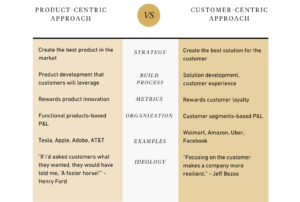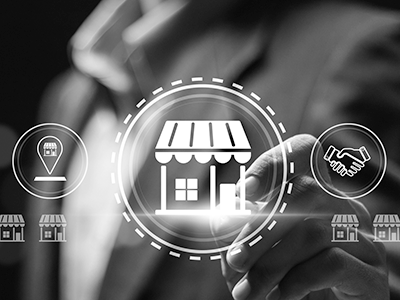There is a great debate raging in the market these days on the “right” way to drive and achieve successful business outcomes. There are generally two schools of thought: In a product-centric approach, the product drives business outcomes and assumes new products and services are created regardless of customer demand. In a consumer-centric approach, customers are the driving force behind successful business outcomes, and products play a secondary role in innovation and development.
The vast majority of companies vacillate between these two approaches—the market “pull” for innovative products vs. the customer “push” for seamless experiences. I would argue that most transformation and innovation efforts have been focused on making trade-offs between one for the other.
These trade-offs cost enterprises billions, making it even more difficult to achieve the business outcomes they set out to solve. So, how do you find the balance between this constant back and forth?
A dichotomy of two extremes
Pitting the two approaches against one another naturally forces us to choose between the two.
Yet, neither of these options offers easy solutions or a blueprint for success. Adobe and Apple had long, turbulent histories before a bit of luck, timing, and Moore’s law propelled them to glory. So is the case with Amazon and Facebook.
These examples are edge cases, but they’re the success stories we hear about most often, which lead business leaders to falsely believe they have to choose between building functionally excellent products and a cross-functional customer experience. Swinging too far in either direction is unsustainable for most businesses. Think of it as the basic physics of a pendulum: the laws of the universe simply won’t allow for one at the expense of the other for an extended period of time.
What one may not realize is that these approaches are two sides of the same coin and that it’s entirely possible to find a balance between disrupting your market with fresh innovative products as well as grow your market share with a world-class customer experience.
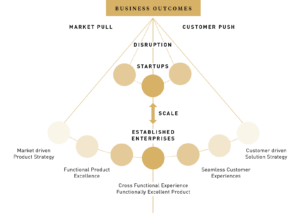 The Pendelum Effect
The Pendelum Effect
To illustrate this push-pull relationship between product and consumer-centric approaches, let us roll back time and take a page from Galileo.
In 1602, Galileo discovered what is now referenced as “The Pendulum Effect”. The law itself can be described as “the movement in one direction that causes an equal movement in a different direction.” Applying this logic to product creation, we see that driving business outcomes seldom go in straight lines or predictable curves indefinitely; the only constant that we can expect is change.
Suppose the equilibrium of our business outcomes is centered around delivering excellent products to an end-to-end engaging customer experience. In that case, the market pull and the customer push can be viewed as disruptions to this equilibrium. The ability to handle the amount of swing from the equilibrium due to these disruptions can be related to whether a company is struggling or thriving to embrace change.
While the centered equilibrium is every company’s elusive unicorn, let us start by accepting the fact that it cannot be a sustained business outcome. You simply cannot move in two directions at once.
Your best chance for success is to expect and embrace the change and design for absorbing both displacement factors (market pull & customer push) and understand the impact on each other.
Trying to overcompensate or ignore these pressure points will not lead to equilibrium. It accelerates the movement away from it. Failure to recognize this has led to the demise of once-popular companies like Blockbuster and Sears.
You are probably wondering, “This is all great, but how does this relate to my situation?”
Let’s start with the obvious fact that all companies–big and small, new and old–are subject to the pendulum effect. While the impact of the disruptions will vary widely and is unique to each company, the patterns on how to recognize and address them are few and familiar to most.
It Starts Where You are on Your Journey
- Are you a startup trying to find your place in the market?
- A small to midsize company expanding rapidly because your ideas took shape?
- A large enterprise with years of storied legacy trying to fend off disruptors within your industry or maybe orthogonal to your line of business?
No matter where you fit in this scale, the effects can be felt constantly over time. The amount of impact, however, will depend on the decisions made over time–every one of them is good at that point in time for that immediate need.
If you are a startup, you can adapt and adjust very quickly, but the impact of every decision can be a matter of survival. Your funding might depend on it.
Suppose you are a large, established enterprise with a loyal customer base. In that case, each decision might not be a “matter of survival,” but they add up over time to cause an exponential effect. You have a longer runway to absorb disruptions, but they will take a lot of effort to mitigate.
No matter where you are in the spectrum, your ability to plan and embrace change directly impacts whether or not your company will thrive for an extended period of time.
So a better question for product managers to ask themselves is not “which approach do I choose?” Rather, it should be ‘How do I build functionally excellent products?’ and ‘How can I provide a seamless, cross-functional experience for my customers and employees?’ in such a way that accounts for change over time.
The way we do it is with a Product Approach with customer always in mind.
The Product Approach: Finding Balance
A good product-centric approach requires an understanding of the cross-functional behavior of the customers and employees. In contrast, a good customer-centric approach provides both functional excellence and the ability to scale.
While functional excellence can be achieved through durable and innovative products, true value to your customer is realized in the cross-functional leverage of these products. Just ask your customer support team, and they will spend hours discussing the need to better balance the functional products with cross-functional customer queries.
“How can I build functionally excellent products?” and “How can I provide a seamless cross-functional experience to my customers (and employees)?” are not two independent questions but parts of the same answer.
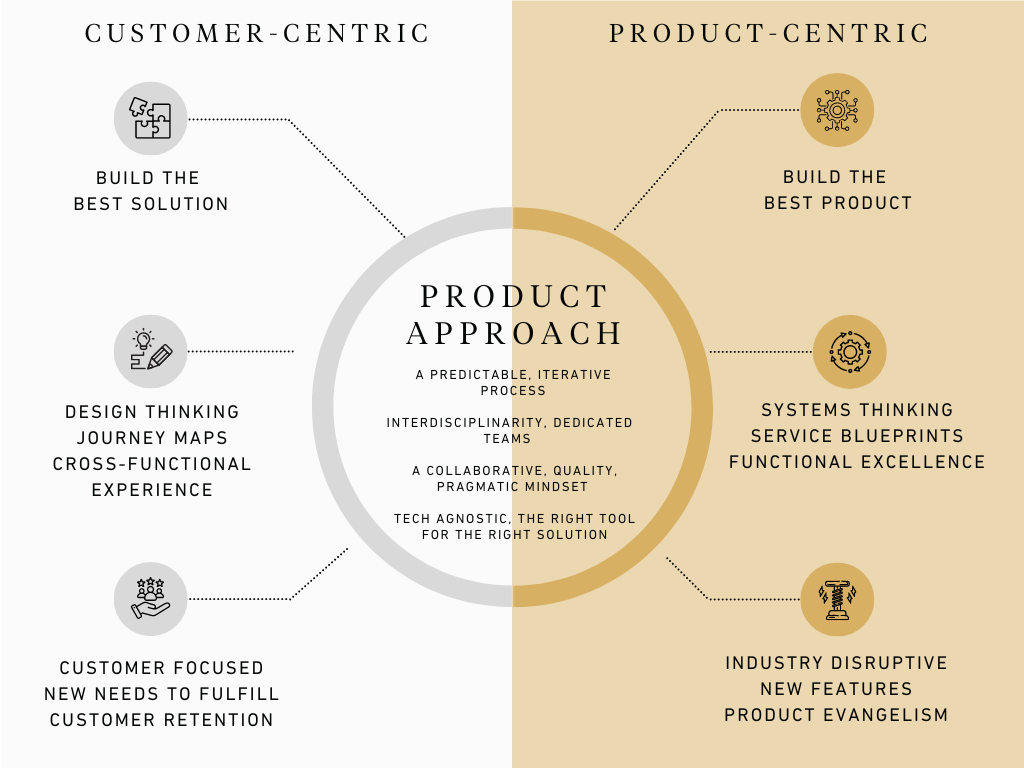
The answer is not about which approach is better (“OR”), but how to effectively build a balanced approach (“AND”) that is designed to maintain equilibrium while driving successful business outcomes to your organization.
A balanced approach requires us to understand the common and unique patterns within and across these two approaches. No matter the approach, the need for a collaborative, quality-focused, pragmatic mindset is essential. Similarly, an iterative and predictable approach with a network of skilled teams is critical for achieving productivity outcomes.
While we started with the two extreme approaches, a balanced approach will be the most pragmatic way for most organizations to drive successful business outcomes. Our approach to engineering products successfully allows for the best of both product-centric and consumer-centric worlds to co-exist. Such a balanced approach requires grounding on some common key principles:
Key Principles to Implementing a Product Approach
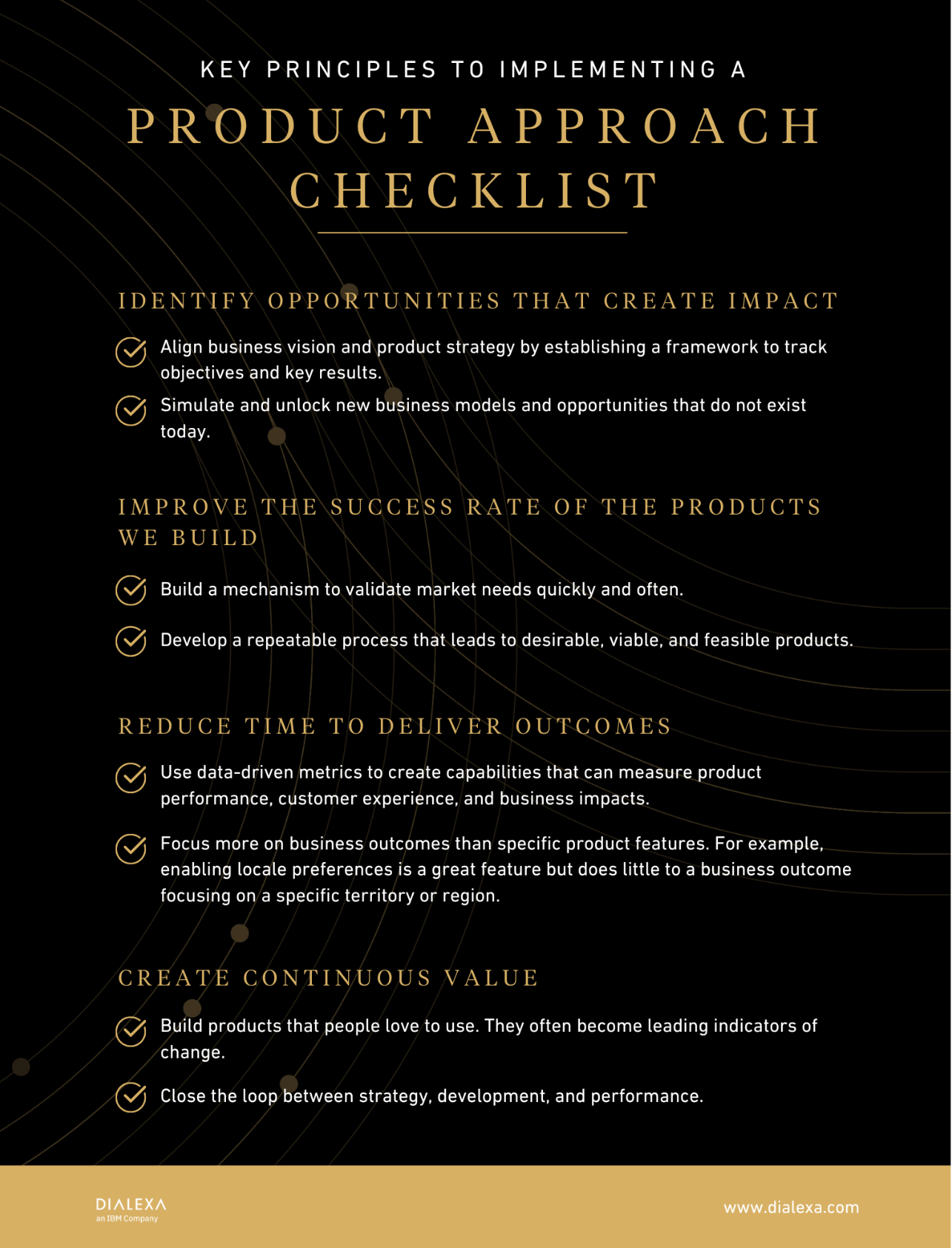
Identify opportunities that create impact
- Align business vision and product strategy by establishing a framework to track objectives and key results.
- Simulate and unlock new business models and opportunities that do not exist today.
Improve the success rate of the products we build
- Build a mechanism to validate market needs quickly and often.
- Develop a repeatable process that leads to desirable, viable, and feasible products.
Reduce time to deliver outcomes
- Use data-driven metrics to create capabilities that can measure product performance, customer experience, and business impacts.
- Focus more on business outcomes than specific product features. For example, enabling locale preferences is a great feature but does little to a business outcome focusing on a specific territory or region.
Create continuous value
- Build products that people love to use. They often become leading indicators of change.
- Close the loop between strategy, development, and performance.
How We Build Successful Products
The principles alone do not guarantee successful business outcomes. How we apply those principles to close the loop between strategy, development and performance are critical to business outcomes—as well as technology and productivity outcomes.
With more and more companies adopting a product mindset for development, it is important to emphasize that launching a product to the market is Day 0. How you continue to approach nurturing the product–and its ecosystem–dictates its growth and survival. Without a good strategy and data-driven metrics to measure its performance continuously and collaboratively, it becomes much harder to keep up with change.
Most organizations struggle with a linear or siloed approach to connect strategy, development, and performance. Each has value, but they hold the key to something very powerful. The ability to truly embrace change.
This is why as Product Engineers, we view product transformation more like a fingerprint, a cohesive and continuous loop unique to the business that allows you to iterate across strategy, development, and performance. These functions feed off themselves over time to drive successful business outcomes. And like a fingerprint, the recipe for a successful product is to be unique.
Putting a Balanced Approach Into Action
Over the last decade, our mission has been to make every company a great technology company. As project engineers, and throughout that journey, clients have come to us requesting help with their customer experiences, while others have asked us for help figuring out their product capabilities. Time and time again, we seamlessly transition between product-centric and consumer-centric approaches to help them achieve those goals and achieve their desired business outcomes.
While our pragmatic framework and approach (aka a balanced approach) may come naturally to Dialexans, it doesn’t initially come naturally for most of our clients. We are putting pen to paper–actually finger to keyboard–to help articulate our learnings to you, layer by layer, concept by concept, one idea at a time.
What is your next product launch?
Do you have plans to build something extraordinary? Perhaps it’s the next big solution to make consumers lives easier, like Amazon. Or maybe you have bigger plans and want to launch industry disruptive technology with new features like Tesla. Whatever it is, Dialexa’s approach to building successful products will get you closer to achieving meaningful business outcomes. Learn more about our product capability and talk to an expert →
ABOUT THE AUTHOR

Vivek Vijayaraghavan is a Partner, Technology & Portfolio Strategy. He joined Dialexa in 2022, after bringing 30+ years of blended experience in Information Technology, Travel, Transportation, Hospitality, Education, Restaurant, Logistics, Waste Management, Manufacturing, Retail and Financial Industries. Prior to Dialexa, Vivek was an Affiliate at the Feld Group Institute. Vivek specializes in closely working with clients to help define and deliver major IT transformation and modernization initiatives while bridging the gap between business and technology.
Connect with Vivek on LinkedIn



